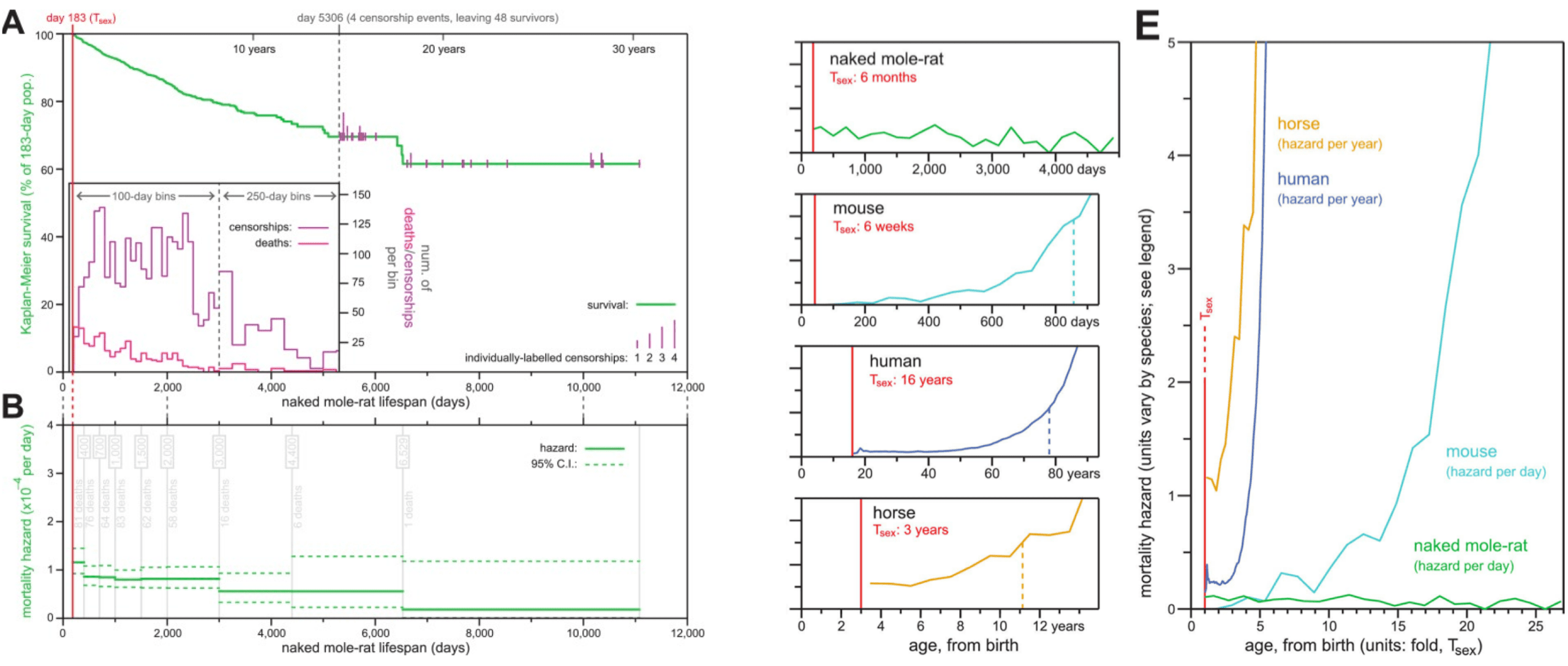Abstract
The longest-lived rodent, the naked mole-rat (Heterocephalus glaber), has a reported maximum lifespan of >30 years and exhibits delayed and/or attenuated age-associated physiological declines. We questioned whether these mouse-sized, eusocial rodents conform to Gompertzian mortality laws by experiencing an exponentially increasing risk of death as they get older. We compiled and analyzed a large compendium of historical naked mole-rat lifespan data with >3000 data points. Kaplan-Meier analyses revealed a substantial portion of the population to have survived at 30 years of age. Moreover, unlike all other mammals studied to date, and regardless of sex or breeding-status, the age-specific hazard of mortality did not increase with age, even at ages 25-fold past their time to reproductive maturity. This absence of hazard increase with age, in defiance of Gompertz’s law, uniquely identifies the naked mole-rat as a non-aging mammal, confirming its status as an exceptional model for biogerontology.
Why Is this Paper Important?
Calico scientists Graham Ruby, and Rochelle (Shelley) Buffenstein set out to quantify the unique aging properties of naked mole-rats. Shelley, a scientist whose research focuses on the comparative biology of aging, has studied naked mole-rat biology for more than 30 years and Graham is a computational biologist interested in quantitative genetic analysis to describe the aging process. Together with colleague Megan Smith, they wanted to understand if naked mole-rats followed the mathematician Benjamin Gompertz’ assertion, first postulated in 1825, that humans show an exponential risk of dying after they reach adulthood. Subsequently this observation of increased risk of dying as you get older, has been shown to hold true for many other species as well.
For example, in keeping with Gompertz’ laws of mortality “the chance of dying for mammals such as humans, horses and mice, among others, increases exponentially with age past sexual maturity. In contrast, Graham, Megan, and Shelley demonstrated that naked mole-rats show little to no signs of aging, and that their risk of death does not increase even at 25 times past their time to reproductive maturity. These findings are clearly in defiance of Gompertzian laws.
While this was a surprising and interesting finding, it’s just the beginning of our studies, not the end. This research opens new avenues of research and understanding of aging. Moreover, this research is important because we can now look deeper into the biology of naked mole-rats to see if there are fundamental molecular mechanisms that allow it to defy Gompertz law and delay and attenuate the aging process and whether the pathways or genes involved in this abrogated aging phenotype might also be conserved and or manipulated across other species, including humans.
Calico scientists are working to sequence the entire genome of the naked mole-rat which we hope offers some clues at the genetic level about how they age.
